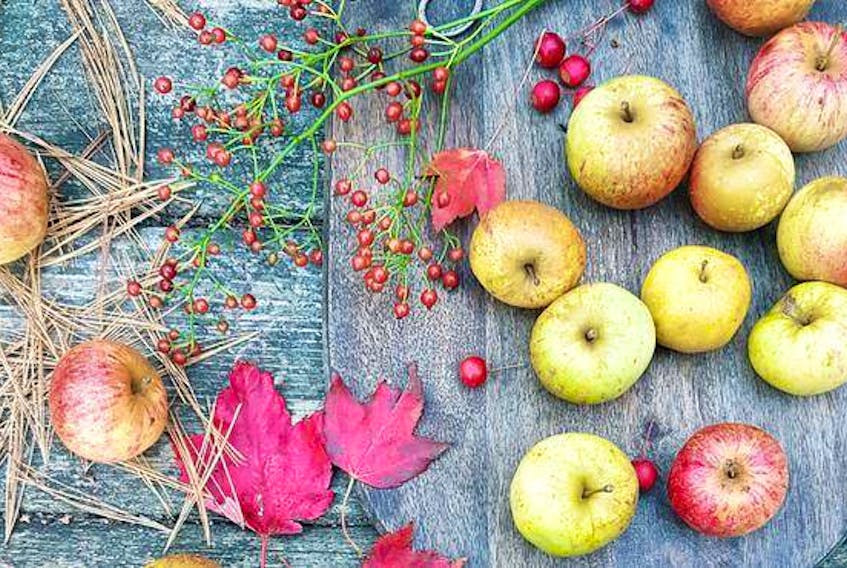Every year, as we have for the past 10 years, we hit Highway 101 and head out to the Valley with a carload of little boys to go apple picking. It’s a tailor-made outing for kids needing instant gratification. How better to let kids in on one of the wonders of the world? Here, you say. Eat this. Tell me there’s anything better.
Letting them run wildly through apple orchards, picking apples with fancy names like McIntosh, Ida, Gala and Honeycrisp, they learn the value of a growing season and that an apple picked directly from the tree tastes better than a store-bought one.
Frolicking through apple orchards is quite honestly my favourite fall pastime, but it struck me this year that the kids had already pre-decided, even as we were lining up to collect our u-pick bags, that Honeycrisps were the way to go and far superior to all others. Clearly the apple marketing machines had done a good job, which is why as parents we shell out double the money for them.
The kids don’t care much for the great sweep of history or the saga of a region told through blossom and yield, but a short history of the apple in Nova Scotia might go something like this: Settlers arrived, bringing with them hopes for a prosperous future and bags of apple seeds. French settlers in Annapolis Royal established the first orchards in Canada in the early 1600s. As they were planted, every seed and every apple became a new variety. Many of the great Canadian apples we know today, were not deliberately cultivated but rather “discovered” in wild orchards, as escaped offspring of the trees the European colonists brought with them.
Bitter spitters
These “original” trees produced wildly different fruit than the large, sugary orbs we are familiar with today. They were knobby, sour things that were often tart and bitter and referred to as “spitters” — grown for drinking more than eating. Which is exactly what they did with the apples — pressed the juice and allowed it to ferment into cider.
Today we have access to a tiny fraction of apples compared to what was once available. Just over two dozen varieties of apples are grown commercially in Nova Scotia and six varieties dominate the marketplace. The McIntosh represents 40 per cent of the total crop, followed by Red Delicious, Spartan, Cortland, Empire and Idared.
In an effort to teach the kids that apples grow wild almost everywhere — desperately trying to change the falsehood that imperfect food is bad food and that wild apples make better cider than the pretty cultivated ones — I take them on an excursion around the neighbourhood and through the wild orchards of our friends’ cottage, to pick the lowly wild apples, the malus sieversii.
Despite the questioning looks from the kids as to why they were being made to pick this motley collection of apples that looked nothing like their prized Honeycrisps, they played along, happy to be outside.
Every tree we picked from was different. Unlike their cloned, cultivated cousins, the beauty of wild apples is that each tree brings a new surprise. The colours ranged from golden to olive green; blush pink to bright red ones. No two tasted quite alike, either. Some were astringent and mouth-puckering while others were sweet as nectar and tasted like pineapple. What these orbs of mottled green and red lacked in size, they make up for with their abundance.
The true crab is thorny with cupped, five-petalled flowers and oval, toothed leaves. The fruit is round and about two centimetres in diameter. There is no such species as a “crabapple” as such; rather, it is a reference to size. If you cut it horizontally it’ll have the star shape of an apple core, not a single seed.
The fascinating aspect of apples is that every apple seed is totally different than the parent. Something like snowflakes, no two apple seeds are genetically alike and the kind of tree each one will produce is a mystery.
I am not alone in my quest for wild apples to press for cider. There’s a recent trend of cider-makers reclaiming some agricultural part of our history by doing something with the wild fruit. For good cider you need four elements: sugar, tannin, acid and an aromatic — crabapples contain all four in abundance. A balanced blend of wild apples can make a cider far more intriguing than one made with common eating apples.

Crabby cider
Jay Hildybrant of Chain Yard Cidery is one of the adventurous craft cider-makers in Nova Scotia using wild apples. “Just today I picked some Geneva crabapples to use in our next ferment,” Hildybrant tells me. “I’ve used various crabapples in different blends. I especially like to add them to finished wild (indigenous yeast) ferments to add an extra dimension to the final flavour profile.”
Making cider is very much like making wine. It depends on terroir, or sense of place — influenced by the soil, weather conditions and cider style — to create a unique personality and taste.
Just because an apple has tannin or acid, however, doesn’t mean it will make good cider. The experienced palate can get a hint of what cider the apple will make, but the only way to know for sure is to press and ferment it.
“Every time I think I’m able to identify a flavour profile of a particular wild apple and direct it to memory, my confidence is shaken when I taste the fruit the following season, even from the same tree,” says Hildybrant.
“I know my cider apple profiles and can accurately predict the flavour outcome of different ferments but the wild apple always keeps me on my toes. Perhaps this is part of their distinctive charm.”
Any apple can be used for cider-making, but if grapes are to wine as apples are to cider, then just as the characteristics in grape juice aren’t found in a chardonnay or cabernet, there are specific qualities in a “cider” apple that flourish in fermentation.
“Crabs bring an extra dimension during fermentation. They provide phenolics that can alter the complexity of the cider in tandem with the fermentation kinetics. They tend to give the cider ‘backbone,’ a little something extra that can stretch the palate, sometimes creating unique secondary and tertiary notes,” says Hildybrant.
The popularity and growth of craft cider is not a new phenomenon but rather a return to old roots. While cider-making began with settlers, today’s cider boom has more in common with the modern wine industry. Through modern practices such as cultivated yeast, forced carbonation and stainless steel fermentation tanks, producers these days are able to fine-tune their ciders, with consistency being the main goal.
“At Chain Yard we work with individuals who are exceptionally passionate about the wild apple and have even made maps to pinpoint unique wild trees,” says Hildybrant.
“We know that the completed product will highlight the terroir of these trees and there is something magical and romantic about this concept. We’ve used wild apples from old Acadian orchards and this touches on something in Canada’s apple history that is quite unique, and I like to think that this something special comes through in the cider. Still there remains a notion here on the East Coast that cider needs to be sweet and taste like apples, so until this mindset changes, crabapples will for the most part remain unused here in Nova Scotia.”
Annapolis Cider Company’s Melanie Eelman has also experimented with a number of crab apples and recently crafted a rosé cider exclusively from them.
“While they are generally not the tastiest apples to eat, their attributes lend themselves to making great cider,” says Eelman.
Geneva Crabapples are unique red-fleshed crabapples that produce rose-tinged ciders that have distinct, intense flavour notes of tart apple.
“Ciders crafted using crabapples in blends demonstrate that we can produce unique, complexly structured ciders in Nova Scotia,” says Eelman.
“In North America and Nova Scotia in particular, there are very few traditional cider apples, as table or dessert apples dominate the market.
“Table apples are typically low in tannins that can lead to ciders that are lacking in body. The addition of crabapples to these blends produces higher quality ciders with added complexity.”
Eelman believes that as the popularity of cider increases, cideries will increasingly turn to wild apples to create unique blends and characteristics that impart a sense of place and heritage.
“Foraging for wild apples includes hunting for native wild crabapples and searching out abandoned trees of hard-to-find heirloom varieties typically found on old farmsteads and overgrown pastures. As the interest in cider grows, cider-makers will continue to explore varieties old and new in the quest for crafting great cider, and the use of wild apples definitely fits with that,” says Eelman.
Professional forager Fred Dardenne tells me that most of the wild apples he picks from Nova Scotia are sent up to Quebec, where cider houses and chefs have already discovered their unique characteristics.
“The best wild apples are the older, ripe yellow apples. If I were a cider-maker . . . I would use old wild apples and old rose hips that would create a wonderful hundred-per-cent Nova Scotia cider. Oh, and I would also add a touch of myrcia gale seeds for a hint of citrus,” says Dardenne.
If you can put aside the idea that an apple needs to look perfect, round and red, then a wide world of flavours and textures awaits.
The taste we associate with an apple is narrow compared to what you can taste in the wild. Wild apples foraging offers us an escape into a delicious world of the unknown without any investment but time.









